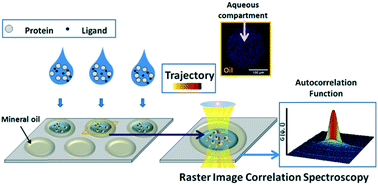Monitoring few molecular binding events in scalable confined aqueous compartments by raster image correlation spectroscopy (CADRICS)†
Abstract
The assembly of scalable liquid compartments for binding assays in array formats constitutes a topic of fundamental importance in life sciences. This challenge can be addressed by mimicking the structure of cellular compartments with biological native conditions. Here, inkjet printing is employed to develop up to hundreds of picoliter aqueous droplet arrays stabilized by oil-confinement with mild surfactants (Tween-20). The aqueous environments constitute specialized compartments in which biomolecules may exploit their function and a wide range of molecular interactions can be quantitatively investigated. Raster Image Correlation Spectroscopy (RICS) is employed to monitor in each compartment a restricted range of dynamic intermolecular events demonstrated through protein-binding assays involving the biotin/streptavidin model system.


 Please wait while we load your content...
Please wait while we load your content...